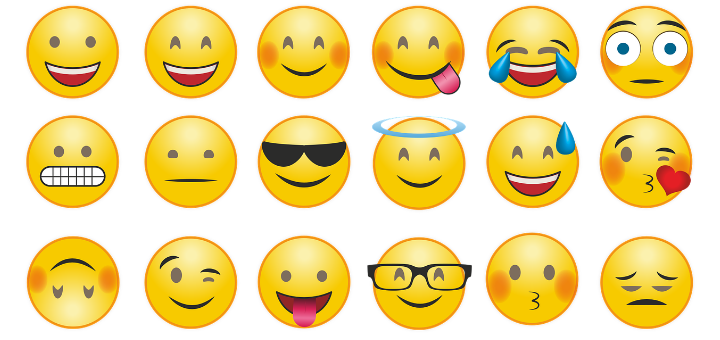This is the sixth installment of a series on Instagram aesthetic trends for 2020. Here are the links to the previous posts in this series:
- #1 Instagram Aesthetic Trend for School Marketers: Treat Your Grid Like Your Homepage
- #3 Instagram Aesthetic Trend for School Marketers: Curated User Generated Content
- #4 Instagram Aesthetic Trend for School Marketers: Focus on Authenticity
- #5 Instagram Aesthetic Trend for School Marketers – Inclusivity
We all know what emojis are. We use them in text messages, email messages, and on social platforms.
Since the early days of digital communications, emoticons have been used to express feelings. After some years of using keyboard symbols, emoji as we know them today became a part of our digital lives.
By the way, many people confuse emoticons and emoji, but they actually have different meanings.
Emoticon is a noun and refers to a set of characters that mimic a facial expression. The words emotion and icon are combined to form emoticon. Examples of emoticons are:
- “:]
- :-]
- o
- :-]
Emoji is the singular and plural form of a different noun than emoticon. An emoji is a small picture which is commonly inserted into text. Emoji come from Japan and were devised in the 1990s. The word emoji is a blend of the words e and moji, which can be roughly translated to mean pictograph.
Here are common emoji:
- 😊
- ☹
Now that we know the difference between emoticons and emoji, the question remains whether there is real value in using emoji in your Instagram posts?
Emoji are more effective than you might imagine. When we look at an emoji the same part of the brain is stimulated as when we look at a human face – so they actually show a real effect on human beings.
According to research conducted by Quintly, emoji lead to up to 47.7 percent more interactions on Instagram. What’s more, a study by Consumer Science Team found almost 92 percent of the online population use emoji. So yes, emoji make sense for school marketing Instagram campaigns, especially if you would like a more intimate connection with your followers. The data suggests a psychological trend. When Instagrammers are scrolling through their feed emoji seem to have some sort of stopping power, eliciting the attention of people who normally wouldn’t notice your posts.
And now, in 2020, the humble emoji is becoming even more popular by being included in Instagram bios and captions. I’ve been seeing more emoji being used with all types of posts, from self-portraits to travel and landscape photography. But I’m not seeing many posts by independent school using them; there are some, of course, but there’s room for a lot more emoji folks!
Emoji are a non-negotiable communication form for millennials and Generation Z. Both of these demographic groups are the most technologically savvy and don’t care much about ads. The trick to getting to them is to pay attention to the ways they engage with content on social media and use it to communicate with them.
Remember social media is supposed to be fun, engaging, entertaining, and a representation of your values. Even if your school is traditional, social media is a place where you can leverage a slightly more relaxed voice.
I suggest you up your emoji game beyond faces; there’s one for almost every aspect of our lives! Animals, food, drinks, arrows, symbols, suns, stars, shooting stars, clothes, shoes, hearts – there are so many emoji to choose from.
So you may be wondering how – or when – you should use them on Instagram. Is there a right way to use them? A right or wrong time? How many should you use? Which ones should you use?
Here are five ways to use emoji on Instagram.
-
Use them in your bio
One way to help your Instagram account stand out is to edit your Instagram bio in a clear, concise, and visually appealing way.
You should definitely consider adding emoji and special characters to your bio. They help break down words in too much more social media-friendly bite-sized chunks, but also give visual clues about your school.
One tactic I’ve seen used is to create a mini-list in your bio and use an emoji as the bullet point. For example, you could list some of your major offerings in a list with diverse faces as the bullet point.
-
Use them in your post captions
As mentioned earlier, posts that include emoji receive a higher rate of engagement. If you want your posts to stand out, use them. You don’t have to use very many, just make sure they are relevant to the context of your post.
Emoji add a hint of color and add an element to your visual storytelling. Think about what emoji your families might enjoy as well as what ones might support your call-to-action. The use of symbols and emoji will draw attention to your calls-to-action and is a very effective way to stand out in the feed.
-
Use them in your comments
You can respond to comments with a simple emoji or a comment plus an emoji. By now you are aware of the importance of commenting and interacting with your followers. Be careful to customize each and every comment and get creative people! No one wants to read “great post thumbs up” over and over again. Of course, there are times when “great post thumbs up” is appropriate, but don’t look like a commenting bot!
Using emoji can instantly make your comment warmer and more fun, especially if you’re interacting with a family for the first time. Long comments are welcome, of course, if you have something substantial to say. Otherwise, an emoji can cut the length of your comment in half while still conveying the full meaning of your response.
-
Use emoji as a hashtag
Emoji hashtags are one of the hottest caption trends on Instagram. To create an emoji hashtag, simply type the “#” symbol before adding your emoji. If you want, you can even add multiple emoji after the hashtag or combine it with words. For example, you could type #pizza and then tap the pizza emoji three times to the end of it. Once you post the caption, your emoji hashtag will become a searchable link, just like regular hashtags.
You can use emoji hashtags in comments too. And, you can use the search tab (marked by the magnifying glass icon in the bottom menu) and use the search field at the top. Tap the search field to begin your search and make sure you select “Hashtags” so it’s highlighted in blue. From there, simply type the emoji you’re searching for into the search field, without adding the “#” before it.
-
Encourage your followers to respond with emoji
You can use emoji not only in your bio, captions, and comments, but you can encourage followers to leave you an emoji as a reply. This is a great tactic for eliciting engagement. For example, you could ask “Using 5 emoji, tell me about your child’s school experience this year.” There are dozens of questions you can ask and then encourage followers to respond with an emoji.
Keep in mind that emoji increase interactivity and encourage engagement. Encouraging your followers to respond with one is extremely easy and fun. Emoji bring out the best in people with just one click. Don’t hesitate to toss the ball back in your followers’ court by asking them to respond with an emoticon.
Keep in mind that emoji increase interactivity and encourage engagement. Encouraging your followers to respond with an emoji is extremely easy and fun. Emoji bring out the best in people with just one click. Don’t hesitate to toss the ball back in your followers’ court by asking them to respond with an emoji.
The trend of using emoji on social media is only getting stronger. A new list of them has been approved for release in the latter part of 2020. Emoji 13.0 includes 117 new emoji and was announced in January 2020. Many of the new emoji will require Unicode 13.0, which was released on March 10, 2020. Here is a list of the new emoji expected to be included in devices made available in the second half of 2020.
Use emoji to help your school stand out and engage with current and potential parents and students on Instagram. But let’s try not to get stuck in an emoji rut, though. At last count, there are 3,304 emoji (including the new ones) out there for your use. So if you’re going to express yourself via pictograph, let’s at least get creative!
However, as a word of caution, don’t overdo it. Ensure you are using emoji to enhance your content, not replace it. Use them sparingly and appropriately.
As school marketers, we know the value of establishing an emotional connection with our audiences; it’s vital to be seen as genuine, approachable, and “human”; emoji can help you accomplish this.
Do you commonly use emoji on Instagram? Why or why not? Please share with the rest of the school marketing community in the comments below.

